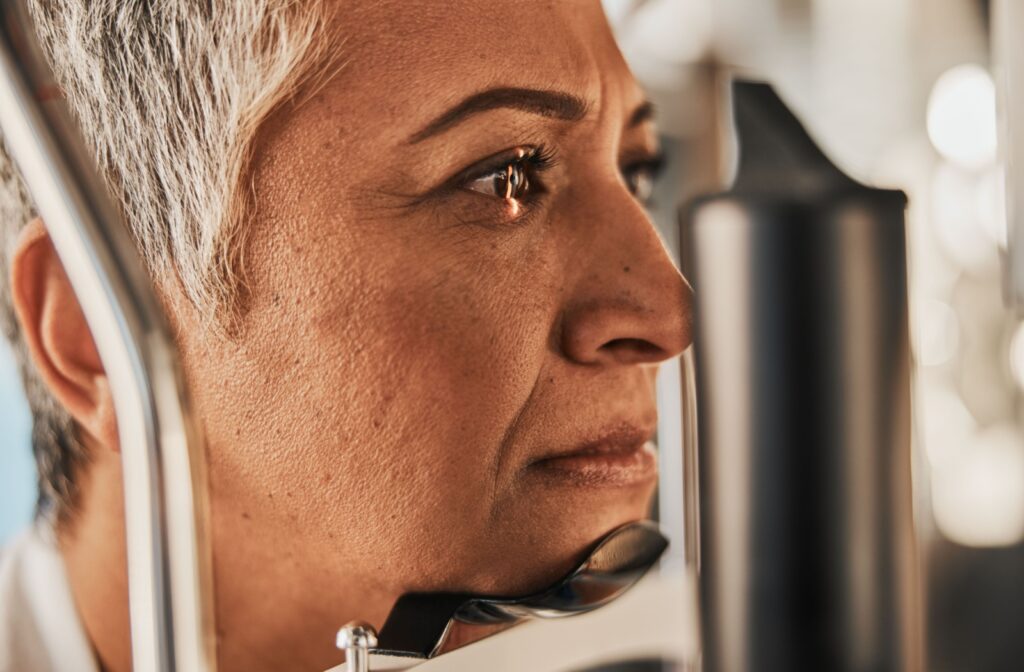Our eyes are among the most critical tools we possess, but many people take them for granted. Imagine waking up one day to find that the world is blurry, you struggle to read, and it’s difficult to recognize the faces of your loved ones. This is what life can be like for people living with age-related macular degeneration.
In the earliest stages, age-related macular degeneration may not showcase any obvious symptoms. However, as it progresses, you may start to struggle to clearly see in the centre of your field of view or in poor lighting. Macular degeneration can distort straight lines into waving, chaotic bends—if you notice this symptom, immediately visit your optometrist.
What Is Macular Degeneration?
The macula is a small but crucial part of the retina responsible for our central vision. This lets us see fine details, identify the distinct differences in colours, and perform tasks like reading and driving.
However, as you age, the macula can start to thin, deteriorating and damaging your ability to perform these tasks. This is called age-related macular degeneration, or AMD. There are numerous causes being researched, some of which are proven and for some, research is still being done. A few examples are:
- Genetic disposition
- Lifestyle
- Exposure to UV rays and high energy blue light
- Underlying health conditions
- Tobacco use
Regardless of the cause, this thinning of the macula eventually diminishes your central vision. For some people, this damage is minor, while others deal with a significant loss of their field of view.
The 2 Types of Macular Degeneration
Age-related macular degeneration isn’t just one singular condition with universal symptoms. Rather, it can be broken down into 2 types:
- Dry AMD
- Wet AMD
Dry AMD
Dry AMD is the more common form, accounting for about 80–90% of cases. It happens gradually as the macula thins and drusen (tiny yellow deposits) form under the retina. These deposits can lead to a slow progression of central vision loss.
Wet AMD
Wet AMD is much less common but also much more severe at onset. This develops when abnormal blood vessels grow under the retina and start to leak fluids into the retinal layers, leading to rapid vision loss centrally. Approximately 10% of people living with dry AMD will progress into wet AMD.
The Signs & Symptoms of Macular Degeneration
There’s a complicated catch with age-related macular degeneration—the symptoms can slightly vary depending on the specific type you’re experiencing.
The Symptoms of Dry AMD
Typically, dry AMD doesn’t showcase any obvious signs at first. As the condition progresses, you may start to experience:
- Blurry vision, especially in the centre of your field of view
- Difficulty adjusting your eyes to low-light conditions
- Dark spots near the middle of your vision
- Difficulty recognizing faces or reading
If you’re experiencing these symptoms, visit your optometrist as soon as you can. If AMD is discovered, your optometrist can give you up-to-date advice on effectively managing AMD and preventing further vision loss the best they can based on the condition you have.
The Symptoms of Wet AMD
Wet AMD is much more serious, and can lead to permanent vision loss if you leave it unaddressed. With wet AMD, you’ll likely experience some or all of the same symptoms as the dry form of this condition, but you may also experience much more rapid onset, with symptoms such as:
- Visual distortions—straight objects may appear wavy or bent
- A sudden and noticeable decline in your visual clarity
If you experience any of these symptoms, seek immediate medical attention; it’s key to preserving your future vision.
Tips for Preventing Macular Degeneration
With AMD, prevention is easier than treatment. It’s crucial to closely monitor your vision after a diagnosis and take active steps to prevent the further loss of any vision.
Try to:
- Maintain a healthy diet rich in leafy greens, fruits, and fish, which can provide essential nutrients such as vitamins C and E, zinc, and omega-3 fatty acids.
- Avoid smoking, as tobacco use is a significant risk factor for developing macular degeneration.
- Protect your eyes from UV light by wearing sunglasses that block 100% of UVA and UVB rays.
- Keep your blood pressure and cholesterol levels in check through regular exercise and a balanced diet.
- Manage underlying health conditions, such as diabetes, which can contribute to eye health deterioration.
However, one of the most important steps is to regularly visit your optometrist for comprehensive eye exams. Your optometrist can monitor any subtle changes in your eyes and vision and give you personalized advice on effectively managing your condition.
Get Checked for Macular Degeneration Today
Remember, your vision is precious, and you should never put it at risk. If you’re worried about AMD, don’t wait for your vision to get worse. Our team is here to help keep your eyes healthy and your vision clear. Book an appointment with us today!





